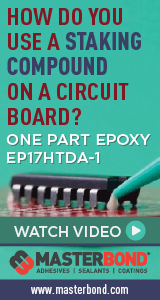|

|
|
| Ask the Experts | |||||||
|
|||||||
|
September 24, 2024 - Updated June 15, 2016 - Originally Posted Solder Mask Thickness ToleranceOur standard PCB fabrication drawing indicates solder mask of 0.8mil thickness. If this is an acceptable standard note, what should be the thickness tolerance plus/minus? J.L. |
|||||||
| Expert Panel Responses | |||||||
|
I do not believe there is a standard value. Solder mask thickness depends on the material and product class. In my experience I've seen as low as 0.4 mils and as high as 1.2 mils.
Senior Manufacturing Engineer Northrop Grumman Edithel is a chemical engineer with 20 year experience in manufacturing & process development for electronic contract manufacturers in US as well as some major OEM's. Involved in SMT, Reflow, Wave and other assembly operations entailing conformal coating and robotics.
Solder mask thickness changes based on the location on the circuit board. The solder mask thickness over the laminate will typically be 0.8 mils or higher. Over the circuit traces the solder mask will be around 0.5 mils or higher. Over the knee of a circuit the solder mask might be as thin as 0.3 mils. These values are typical for screen printed solder masks. The thickness will be a little lower for spray coated solder masks, and a little higher for curtain coated solder masks. You should check with your circuit board suppliers to see what is realistic for their solder mask process.
Field Applications FCT Assembly Tony has worked in the electronics industry since 1994. He worked as a process engineer at a circuit board manufacturer for 5 years. Since 1999, Tony has worked for FCT Companies as a laboratory manager, facility manager, and most recently a field application engineer. He has extensive experience doing research and development, quality control, and technical service with products used to manufacture and assemble printed circuit boards. He holds B.S. and M.B.S. degrees in Chemistry.
The 0.8-mil thickness is probably near the higher end, but in range for a photo imageable mask, provided that the measurement is taken on a flat surface. If you measure it near the edge of a surface feature, it can be much thinner (right at the edge of a trace) or much thicker (between closely spaced traces). You can see as little as a couple tenths of an inch at a trace edge, barely measurable, and as much as 1.6 mils next to a 1-ounce surface trace.
Process Engineer Astronautics Fritz's career in electronics manufacturing has included diverse engineering roles including PWB fabrication, thick film print & fire, SMT and wave/selective solder process engineering, and electronics materials development and marketing. Fritz's educational background is in mechanical engineering with an emphasis on materials science. Design of Experiments (DoE) techniques have been an area of independent study. Fritz has published over a dozen papers at various industry conferences.
Reader Comment
IPC 6012 , #3.7.1 require that the maximum solder mask height above a pad when it used to tent or plug via hole should be 50um.
Mordechai Ben Porat, OMEGA
Reader Comment
Good question. Vendors do not usually define thickness and I have noticed no comments addressing that portion of your question. We request mask thickness and tolerance on top of metal. We are having trouble with the variation of thickness as we are trying to make micro circuits with small ball fine pitch die. Some are responding with 22um +15-10um. That causes issues for cleaning and underfilling. We are currently looking to find vendors with better mask control. :)
Tim Griebel, Starkey Hearing Tech
Reader Comment
Surprise, but the minimum thickness allowed per IPC-SM-840E is no mask at all! Solder mask is allowed to have some skips, and as such has always been considered to be the same as no insulation value because of this. While the latest revisions of the standard were changed to require a minimum of .001" of soldermask, that is considered also to be so thin as to be non-existent. Older designs once used solder mask as an insulator, and thus metal can packages were sometimes designed to sit flat on the board on top of non-common conductors. Today, that is nearly never the case, or at least, it is no longer considered an acceptable practice.
Rikard Tenold, Gost Technology AS
|
|||||||
| Submit A Comment | |||||||
|
Comments are reviewed prior to posting. You must include your full name to have your comments posted. We will not post your email address. |
|
Free Newsletter Subscription
Circuitnet is built for professionals who bear the responsibility of looking ahead, imagining the future, and preparing for it. Insert Your Email Address |
|

|





